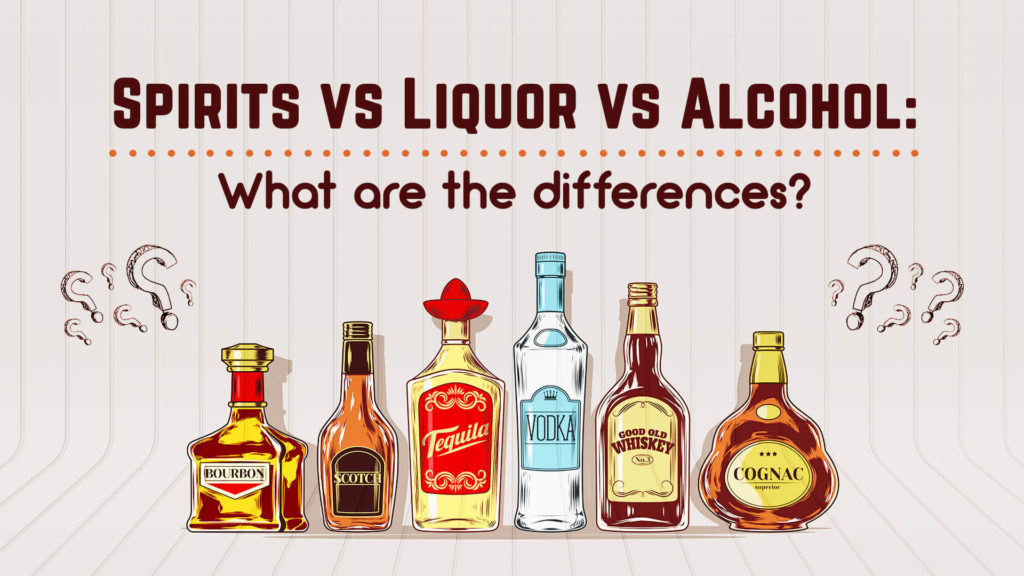Blog
Spirits vs Liquor vs Alcohol: What are the differences?
They have individual flavour profiles, some are mixed in cocktails, and others are best served at room temperature. But other than these evident distinctions, have you wondered what the fundamental differences are among spirits, liquor, and alcohol?
Firstly, what do these drinks have in common? The answer is C 6 H 12 O 6 → 2 C 2 H 5 OH + 2 CO 2. This is the chemical equation for alcoholic fermentation, a process that these beverages all undergo.
However, beyond this common procedure, there is one important distinction: the level of alcohol in each. This is a result of different treatment in the production of spirits, liquor and alcohol.
Liquors and spirits are distilled alcoholic beverages. In most cases, spirits are liquor and liquors are alcohol.
Wine, beer, and cider are all examples of alcohol, but they are not spirits. Confused? Keep reading!
Spirits vs. Liquors
Firstly, when it comes to differentiating spirits and liquor, it depends on how technical you want to get. In a local bar or when you browse alcohol online in Singapore, these names are usually interchanged to mean drinks with very high alcohol content (ABV). These include beverages like vodka or brandy. However, in the process of making such high-alcohol volume drinks, it is a different matter. There is a point when the liquid is referred to as spirit. This is during the process of distillation and the resulting liquid cannot be referred to as liquor at this stage. This liquid is flavourless and has a very high ABV.
In the production of a malt whisky, the spirit ABV can be as high as 75% while a grain whisky can have 95% ABV. It is only after the spirit is reduced, matured, bottled and ends up in your glass that is becomes liquor (and you are now still welcome to refer to it as a spirit!).
Spirits and Liquor
These mean the hard stuff. If you are drinking vodka, brandy, whisky, rum, or tequila, all beverages with around 40% ABV or higher, you are enjoying liquor or a spirit.
These beverages reach very high volumes of alcohol in the distillation part of their production mentioned above. This is when fermented liquid goes through what is known as a still. This is where it vaporises, leaving alcohol.
Following this, the alcohol condenses and goes through the vaporisation step several times, becoming more concentrated with every repetition. It is then reduced to 40% ABV before bottling. This is how your favourite vodka and whisky are produced.
There is also a family of drinks called flavoured spirits. These are produced by soaking a neutral high ABV base spirit in flavouring ingredients such as coriander seeds, dried citrus, or botanicals. The cheaper variety are made by adding artificial flavours to the spirit.
Wine
Wine is alcohol but, compared to spirits (both the kind in the distillery and your glass) and liquor, it has a low ABV. Alcohol is created in the above-mentioned fermentation process. With wine, the sugar levels in a grape play a role in the alcohol content in the final bottle of wine. As a guide, a wine with below 11% ABV is considered low alcohol while 11 – 13.9% is regarded as medium level. A high-alcohol wine has an ABV of 14% or more.
Generally, wines do not exceed 15% ABV but there are exceptions. Fortified wines such as port have a different ABV profile. This ranges from 15% to 18.5% and above. How is non-alcoholic wine made? These wines go through the same basic production process as alcoholic wines. The difference is that the alcohol is removed at a later stage.
Beer and Cider
This popular alcoholic drink is made through several refined steps. As with spirits, liquor, and wine, alcohol is produced at the fermentation stage.
The ABV of beer depends on the style but is commonly between 4% and 6%. Cider production undergoes different stages before it reaches the important fermentation step. This is done at between 4.5 and 25 degrees Celsius, allowing aroma and flavour characteristic to develop alongside an ABV level of 3% to 13%.
Understanding how beer, cider, wines and spirits differ is simple when you realise the differentiation is based on alcohol content and production terms.
Wine, beer, and cider are all alcohol but not spirits or liquor.
Spirits and liquor are the same thing in your glass but not in distillation process.
What they do have in common is they are all alcohol. Check the ABV and select your preference with care. If all this has made you thirsty, feel free to start browsing some wine and spirits online and get delivery to your doorstep! Cheers!

